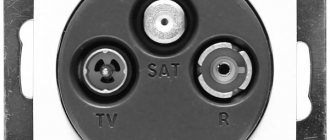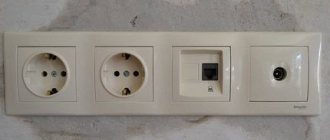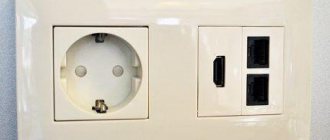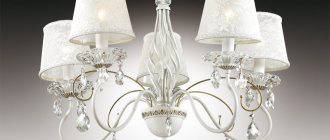Selecting and installing lighting fixtures is one of the most enjoyable stages of home interior design. A beautiful chandelier with a spectacular design can become the “heart” of the entire design of an apartment or house. Properly selected lighting can highlight all the advantages of a room and hide possible flaws.
However, assembling and installing a chandelier is often associated with certain difficulties. Problems especially often arise when connecting models with an abundance of lampshades to a switch with several keys.
But often homeowners can still do without the services of a specialist and install the chandelier themselves. In this material we will look at the main stages of assembly and installation, talk about the intricacies of the electrical connection of the lighting device and provide step-by-step installation instructions with visual photos and useful videos.
Mechanical assembly
As a rule, the main components of any chandelier are easily connected into the finished product, but in difficult cases you will have to rely on the documentation with the diagram.
Usually the lampshades are separated from the horns, the base, and the terminals are packaged next to the other elements of the product. Even a beginner will quickly figure out what to connect to what.
Important: Before starting assembly, you must ensure that all components are present.
Assembly steps
- The upper part of the chandelier base is assembled.
- The plate is mounted on the rod and tightened with a nut.
- Horns for lampshades are installed.
- It is necessary to unscrew the special nut on the base. The horn is inserted into the corresponding hole.
We study the chandelier. If everything is installed correctly, we move on to the next stage. Do not rush to install decorative elements and lampshades; they will be installed a little later.
Checking the kit
At first glance, the contents of the chandelier box may seem like a pile of parts that have little connection with each other. However, the main components of any chandelier are approximately the same, which simplifies the installation process.
When opening the package, you should be extremely careful, as there is a risk of accidentally damaging its fragile parts. The kit must include the following elements:
- lampshades;
- horns;
- frame;
- terminal blocks;
- wires;
- fastening elements.
A mandatory component of the process will be checking the availability of all necessary parts. The package will necessarily contain a document containing an inventory of all the parts necessary to assemble the lamp. This will avoid misunderstandings that arise due to a missing part due to a manufacturing defect.
Understanding the wires
In the case of connecting a chandelier with a switch based on a single key, our task is simplified. If it’s two, then you’ll have to understand the wiring diagram in the chandelier, because otherwise the switch won’t be able to work correctly.
The horns have a separate wire for connecting to the power core. For clarity, the wire colors are offered in different colors, but in some cases the manufacturer uses one visual design option.
The wires are carefully routed through the corresponding hole on the chandelier and grouped together for the actual wiring process.
We connect the wires to one switch key:
- The neutral wires are twisted.
- They usually have a blue or blue color.
- We connect the phase wires.
- Such a vein is framed in white, brown, gray and other colors.
To connect to two switch keys, the main wire must have three functional cores. Conventionally, L1, L2 and N. For correct connection, the zeros are connected as for one key. But the phase ones are divided into two groups L1 and L2 for use on both switches.
Now you need to connect the chandelier to the ceiling. To do this, use a hook or a special fastening strip in the case of a concrete floor.
How to install a chandelier
When installing any chandelier, you need to take into account that this lamp is quite bulky and heavy, so you should take care of the mechanical part of the issue, that is, how to hang the chandelier and what to attach it to. The situation can be different, often apartments already have quite strong hooks. However, you should not install the device relying on the strength of the old hook. Therefore, it is recommended to fasten such multi-lamp lamps using dowels or anchors. The number of dowels depends on the weight of the chandelier and its mounting. It is advisable to disassemble it before installation and remove all easily breakable and fragile elements.
Phase search and final connection stage
Now we have figured out how to properly assemble the chandelier, but all that remains is to connect the wires to the power cores to provide lighting for the room.
Before starting the connection, you should not trust the color of the wires. It is necessary to check the phase and zero using an indicator screwdriver. To do this, you must follow safety measures.
Do not touch exposed wires. But the finger must be pressed against the contact plate. Otherwise, you will not be able to get the correct result.
Finding grounding with a multimeter:
- After checking the wires with an indicator screwdriver, you can use the multimeter in ground search mode.
- To do this, it is connected to the operating state at 220 V.
- The probe is connected to the phase.
- The other probe is alternately connected to the remaining 2 supply wires. The readings are recorded.
- On this basis, the presence of grounding is detected. In most cases it is not used, but it is necessary to check.
If one of the wires shows a voltage of less than 220 V, then protection or grounding is applied. After this, you should turn off the voltage to the entire living area and you can begin connecting the chandelier wires to the main supply wires of the general electrical network.
How to assemble, connect and wash a chandelier yourself - complete instructions for the buyer
The difficult choice of a ceiling lamp and the exciting expectations are over. And now, the desired chandelier has already been delivered to your home and is waiting in a box for its turn to be installed. Is it possible to install a ceiling light yourself without the help of a professional? How to properly assemble it, hang it and connect all the electrics? You will get answers to these questions in this article prepared by lighting specialists ROSESTAR.
First of all, it is worth noting that it is possible to assemble and hang a chandelier with your own hands, and you do not have to be an electrician to do this. To do this, you just need to study the assembly instructions, which are usually included with the purchased lamp, and also know the correct sequence of installation steps. Read more about all this below, and we are confident that our tips will allow you to connect the chandelier yourself and be proud of your achievement.
What you will need
To work you will need the following tools:
1. A stepladder on which you will perform high-altitude work and attach the chandelier to the ceiling. If you don't have a stepladder, you can stand on a sturdy table instead if it's high enough to reach the ceiling.
2. Electric drill/screwdriver to create the necessary holes. The tool should be battery powered, not mains powered, so that you can freely work with it right up to the ceiling.
3. Three screwdrivers: with a flat blade and a Phillips blade, depending on your chandelier fastener, and one more – an indicator one.
4. A multimeter with which you will measure voltage.
5. Soldering iron and soldering tape.
6. Marker for marking attachment points, stationery knife.
7. Pliers for clamping terminals at the ends of wires.
How to assemble a chandelier
The assembly process may vary depending on the complexity of the chandelier. First of all, in order to assemble the chandelier, you need to study the instructions and think over the connection diagram.
Regardless of the number of shades and the design of the chandelier, we will divide the assembly into several stages. Each of them is important, so it is necessary to understand all the intricacies in order to carry out the work efficiently and quickly.
The assembly should be organized as follows:
1. Unpack all parts of the chandelier and arrange them so that everything is at hand. A set of wrenches and screwdrivers is also required. It is better to allocate a table for this and provide good lighting.
2. Check that all parts are in stock. It is very important to make sure of this in advance so that, if necessary, you can return the chandelier to the store or exchange it.
3. According to the instructions, you must install all the elements, starting assembly from the top of the case. Align all parts evenly and tighten them with nuts or other fasteners.
4. Next you need to attach the horns to the chandelier. To do this, they are put on the seats and secured with a nut. They should not be fully clamped immediately. First, it is better to make sure that they are located symmetrically and only then fasten them.
5. Pull the wires through the central tube, if required. Often they are already laid, which simplifies the work.
It is worth remembering that the decor in models with pendants must be attached after installation. This also applies to lampshades; they should not be installed right away, this will simplify installation. It is better to finally assemble the chandelier when it hangs on the ceiling.
If you have a chandelier on a pendant mount, this is a big plus, since its length can be adjusted at any time. To do this, you need to make a cut on part of the wire or disconnect excess chain links.
How to remove a chandelier
Of course, if you are installing a new chandelier not in a new apartment, but as a replacement for an old lamp, you will need, first of all, to remove the old chandelier from the ceiling. Next we will tell you in more detail how to do this.
First , turn off the switch in this room. But simply lowering the switch does not guarantee that you will turn off the power to the chandelier. The ceiling light may not be connected correctly. For example, a phase must go through a switch, that is, the switch interrupts the phase. But it can also be assembled the other way around, so that zero goes to the switch. If this is the case, if the wires come into contact with wet hands, there is a risk that you will receive an electric shock. An indicator screwdriver will help you determine whether a phase is disconnected or not.
Secondly , using a screwdriver, unscrew the fasteners of the chandelier, holding it with your other hand. Do not leave the wires in a state of tension so that the chandelier hangs on them. Instead of unwinding the wires, you can simply cut them right under the electrical tape. All wires under the chandelier must be separated to prevent a short circuit.
Chandelier installation
Depending on the weight of your lamp and what material the ceiling is made of, choose the appropriate mounting method. There are the following methods of attaching a chandelier to the ceiling:
1. Steel ceiling hook
If your chandelier weighs no more than 1.5 kg, it can be fixed to the ceiling using a steel hook. The installation algorithm is quite simple: drill a hole of the required diameter in the ceiling using an electric drill with the required attachment. Screw in the dowel and, applying force, insert the hook.
2. Heavy duty hook with anchor
If your chandelier is more massive, a hook with a heavy-duty anchor is used to install it. It expands after installation into the hole made by the drill, making it a more reliable mount. The length and cross-section of the anchor must correspond to the weight of the lamp and the thickness of the ceiling.
3. Plank
Most modern chandeliers have a special mounting strip. First, it is fixed to the ceiling with self-tapping screws, and then the chandelier is screwed onto it through the mounting holes.
4. Mounting platform
To attach a heavy chandelier to the ceiling, mounting platforms can also be used. They are located inside, under the ceiling, and play the role of a supporting structure. The dimensions of the mounting platform should be wider than the fastener. A hole is made in the center of the support platform for cable exit.
Installation of a chandelier on a suspended ceiling
This instruction will describe how to install a chandelier on an already installed stretch ceiling, under which there is a platform for the lamp. Installation of the chandelier is carried out in 5 stages:
Stage 1. To begin with, we decide on the place where the platform will be located, outline this place with a simple pencil and lubricate the ring with glue around the entire perimeter. Be careful to apply the glue around the entire perimeter without interruption. You need to choose a ring that is not too large so that it does not look beyond the platform of the chandelier.
Now press the ring against the canvas and hold it for a few seconds. It is better not to cut it out right away, but to leave it for a few minutes so that the glue sets properly.
Stage 2. Next, you need to cut out the middle of the stretch fabric with a stationery knife. We release the wires into the resulting hole. If the chandelier platform has sharp edges, they must be wrapped either with reinforced tape, or with regular adhesive tape or tape. Then sharp edges will not damage the canvas.
Stage 3. We try on the platform, set it level and mark the places where the self-tapping screw will pass through the canvas. Pieces of reinforced tape or adhesive tape must be glued over these marks. Now we screw the chandelier platform itself with self-tapping screws using a drill.
Stage 4. At this stage we connect the chandelier and connect the power supply. The best way to do this is to use terminal blocks. The screw in the block should hit the wire core, not the braid.
Stage 5. Attach the chandelier itself. You need to get the bolts into the hole and tighten the decorative caps that come with the chandelier.
From the following video you can learn how to install a chandelier on a suspended ceiling step by step using a platform under the canvas:
And this video will tell you how to install a chandelier on a suspended ceiling if you don’t have mortgages:
Connecting a chandelier
First of all, when starting to work with electrical equipment, familiarize yourself with the safety rules. And then we provide step-by-step instructions on how to connect a chandelier with two switches and a chandelier with LEDs.
Electrical safety rules
Perhaps the most difficult thing you will have to face when connecting a chandelier is working with electrical wiring. But if you follow the recommendations below, you can work calmly without fear for your life. So:
1. Switch the machines on the panel to the “Off” or Off position. If your distribution panel is old and does not have such toggle switches, then unscrew the plugs.
2. The second and most important rule: before touching the wires, disconnect them from the power supply.
3. Using an indicator screwdriver, check that there is no voltage in the wires.
4. When connecting the lamp to electrical wiring, do not twist the wires together. It is better to use terminals or connecting blocks for this.
5. Do not skimp on consumables and fasteners, as the service life of the product depends on this, and, more importantly, your safety.
6. Don't forget to ground the wires.
Connecting a chandelier to two switches
If your ceiling light has more than one bulb, it makes sense to make a separate switch for each group of bulbs. Thanks to this, you can adjust the lighting power and turn on the amount of light you need, depending on the needs of your household. You can connect the wires in such a way that one key turns on one part of the chandelier, and the second key turns on another part of the chandelier. The wires are connected as follows:
1. Removing the switch
Each switch has a recess to allow you to hook it and remove the key without causing any damage.
2. Continuity of wires in the switch - how to find the phase
To check, use an indicator screwdriver. Usually the white wire is a phase wire, and there should be nothing on the others. The wire that lights up is common, the two outgoing ones don’t light up.
The common wire in the switch is the phase that comes from the distribution box.
3. Testing wires under the ceiling - how to find zero
To strip the wires, use a tool called a wire stripper. It can be purchased at any hardware store. Use a stripper to remove the insulation.
The common wire from the ceiling is zero, which comes from the junction box.
Next, the wires must be connected together either using a terminal block, or by pressing them with pliers. Go to the ceiling and use the indicator to determine which wire is not glowing. Two of the three wires will light up - these are phases. These are the outgoing keys. The wire that does not light up is common. In the switch 1 wire is lit, 2 wires are not lit, and in the chandelier it’s the other way around.
4. Wiring in the chandelier for a two-key switch
Under the chandelier mount you will see two wires, but for a double switch you need three. At this stage, you need to reveal the area of the chandelier in which the wire connection is hidden. Usually it is located directly under the base, attached to the ceiling. You will see two wires coming from each arm of the chandelier. Each pair of wires goes to one cartridge. From each such horn, take out the phase and zero that belong to them. The blue wire is always zero, and the brown wire is phase. The color scheme is prescribed in the electrical safety rules.
Take one blue wire from each light bulb and twist them all together. Since we will have two switches, we will divide the existing light bulbs by the number of switches. For example, if you have a five-arm chandelier, two light bulbs can be turned on by one switch and three light bulbs by another.
Take the two brown wires and twist them together. This will be phase L1 and the first switch. We also twist the other three brown wires together, this will be phase L2. The neutral wire is usually designated by the letter N.
You will get 3 twists: one twist of blue wires, consisting of five, the second – of two brown wires for 1 switch, and the third – three brown wires for the 2nd switch.
Remember that the phase wires pass through the switch, and the neutral wire goes directly to the chandelier. The connection occurs as follows:
1. Take our blue twist and connect it to the neutral wire on the ceiling.
2. We connect two wires per switch to one phase wire, the one we defined as L2. We connect the second twist of three wires to the first phase wire, that is, L1.
3. We return to the chandelier and take 3 terminal clamps. We take a twist of wires from the first phase, insert it into one clamp, and a twist from the second phase into another clamp. We take the third twist, that is, the neutral wire, and also insert it into the clamp.
4. Now we have 3 clamps in the chandelier and 3 wires in the ceiling. The double twist from two light bulbs is connected to phase 1, the triple twist from three light bulbs is connected to phase 2, the neutral wire from the chandelier is connected to the blue wire from the ceiling.
In this video, a lighting technician explains step by step how to connect a chandelier with 5 lamps to a double switch.
And in this video you will see a detailed, understandable explanation of how to connect the wires in the chandelier itself, as well as in the junction box for connecting a double switch:
Connecting a chandelier with LEDs
The main difference in connecting an LED chandelier is that it can be controlled not only using a switch, but also using a remote control. And even if the basic configuration of the lamp did not include a remote control, you can purchase it yourself and connect it separately.
First of all, assemble all the parts of the chandelier using the steps described above. Next, do not forget to turn off the power to the wires to protect yourself during work. Using an indicator screwdriver, find the phase and connect the phase wire to the block.
Usually a mounting strip is supplied with the LED chandelier. The straight strip is fixed with 2 dowels, and the cross-shaped strip with 4. Hang the chandelier on decorative bolts and securely fasten it to the ceiling. Then check the functionality of the lamp.
In this video you can clearly see the process of assembling and connecting an LED chandelier, as well as its dimmer remote control.
Why do light bulbs in a chandelier explode when turned on?
Exploding light bulbs when you turn on the light in a lamp, floor lamp or chandelier is not a rare occurrence. Let's figure out why light bulbs burst, and what should be our actions to avoid this trouble?
1. Questionable quality of components or manufacturer defects. When purchasing different types of light bulbs, it is better not to save money, as lighting fixtures often explode due to their unstable operation. It is better to purchase light bulbs from trusted manufacturers.
2. Old switch. It is necessary to carefully monitor the technical condition of cartridges, switches and wires. Light bulbs will continue to burst if regular inspection is not carried out.
3. Lack of ventilation in the chandelier shade. During operation, the light bulb becomes very hot, the lamp shade prevents the air from rising up, so overheating occurs and it burns out or bursts.
4. Perhaps one of the most common causes is power surges. When you turn on the chandelier, the voltage from the network goes directly to the light bulb, as a result of which it can not only burn out, but also explode. Therefore, stabilizers are often installed in homes to mitigate voltage surges.
5. A light bulb in a chandelier or lamp may explode from mechanical impact. As a rule, this reason is observed in dynamic lamps. Shocks and shocks will definitely not contribute to reliable operation. For example, if a lamp dangles from a gust of wind, then the spiral in the light bulb may break or it may even burst. It's better to create normal conditions
for lamps, or replace them with less sensitive models.
A broken light bulb may be an isolated incident, but when it happens frequently, you should find the cause. Fixing problems with your home network is a matter of safety, health and saving money. If an exploding light bulb in your home is not uncommon, we advise you to follow these recommendations:
1. Replace regular light bulbs with LED ones, they last longer.
2. Try to replace old wiring and switches with new ones as soon as possible.
3. Select lighting lamps and lamps of the same power.
4. Buy light bulbs from trusted brands.
5. Do not entrust the assembly and installation of lamps and chandeliers to a person who does not have the appropriate skills.
6. Do not leave lights that can be turned off unnecessarily on.
So, we have looked at several reasons for light bulb failure. As practice shows, the recommendations we have given will allow you to get rid of such an unpleasant phenomenon as the explosion of lighting lamps.
How to wash a chandelier
Crystal chandeliers are one of the most popular types of ceiling lights. In addition to maintaining the required level of lighting, they create a special atmosphere and fit perfectly into any interior.
Having spent money on a good chandelier, we expect that it will delight us with its brilliance forever. However, crystal tends to attract microparticles of fat and dust, and therefore needs to be cleaned. In addition, it may lose its transparency and beauty.
Two ways to wash a crystal chandelier without removing it from the ceiling
How to wash a crystal chandelier with pendants without removing it from the ceiling? You can use several simple methods that will help you achieve the perfect result and do not require much expense.
Important! Follow safety precautions. The chandelier must be washed with the light bulbs turned off.
Method number 1.
- Use microfiber to wash the chandelier. It leaves no streaks and wipes any surface dry.
- If possible, remove small parts. This will allow you to achieve the right result and speed up the process. Place small parts on a towel so that they do not touch each other. When pouring cold water over them, make sure that there is no dry space left.
Important! The water temperature should not exceed 30-40 degrees, otherwise the crystal will become cloudy.
- When choosing a cleaning product, you can use a limescale remover, grease remover or dishwashing detergent.
- Apply the cleaner, spritzing each part. Leave for 15-20 minutes. Try not to rub, but gently blot with a soft sponge. Rinse with water from the shower.
- Fill a basin with cool water and add a little ammonia (it adds shine). First, dip the parts in running water, then in water with ammonia.
- You can dry the parts in any convenient way. The main thing is that they do not get confused, do not touch each other and dry evenly, without smudges. Thanks to alcohol, they dry instantly.
Method number 2.
You may be thinking, “I don’t want to capture small details.” How can you wash the chandelier in this case? There is another method you can use.
- Take two pairs of cotton gloves.
- Dip one pair in a solution of vinegar, water and dish soap. And wearing gloves, wipe each crystal.
- After this, use a dry pair of gloves. After putting them on your hands, wipe all parts dry.
With these simple methods you can keep your chandelier in its original form for a long time.
If you still have any questions about ordering, assembling and installing a chandelier, you can ask us using the free online chat in the right corner of the screen. In addition, in the comments you can share your secrets of assembling and installing chandeliers or leave recommendations that will be useful to other visitors.
We really hope that thanks to the recommendations described in this article, your room will very soon be decorated with a new lighting fixture, assembled with your own hands. As you have seen, the algorithm for installing a chandelier is not that complicated, and with a little effort, you can figure it out without even being an electrician. And if you are still in search of the ceiling lamp of your dreams, we invite you to the huge lighting catalog of the ROSESTAR online store. Among our assortment, there is a lamp for everyone to suit their taste, ideally suited to your interior.
Authors of the article: ROSESTAR company specialists
Products from the article:
Chandeliers for the living room
Modern chandeliers
Classic chandeliers
Hanging chandeliers
We connect the chandelier with the supply wires
This is the most important step because you need to connect the correct wires. For reliability, VAGO terminals and PPE caps are used.
PPE caps or connectors are often included with the chandelier. For use, the wire is carefully wrapped around the product. Now you need to complete the connection of the corresponding wires. After this, the chandelier body structure is closed, lamp shades and decorative elements are installed.
Chandelier on a rod ALFA 27006 BALLANT buy in the online store in Moscow and St. Petersburg
- Checking the presence of 220V input voltage.
- Checking the open circuit voltage 12...15V at the output of the diode bridge. If this voltage is not present, check the limiting capacitor, diode bridge, filter capacitors, zener diode. To eliminate the influence of subsequent parts of the circuit, disconnect the load of the power supply circuit by cutting the track on the board.
- Check the voltage at the input and output of the +5V stabilizer.
- Check the operation of the decoder. If there are signals from the remote control, voltage will appear at the outputs of the decoder and the corresponding bases of the transistors.
- Check key transistors. When they open, the relays should turn on.
- When the relay is turned on, the phase should appear at the corresponding controller outputs.
Learning to assemble an LED chandelier with a remote control
Many people do not understand how to assemble a chandelier with a control panel, since many parts are offered. Therein lies the complexity of this matter.
- You will have to spend time assembling the structure. Usually a film is applied to shiny elements. It needs to be removed.
- After this, everything is untwisted and connected to the main structure, glass elements with rhinestones are inserted. At the final stage, the light bulbs are screwed in.
- After this, you need to devote time to the receiver and controller, but there are different power supplies for adequate operation of the light bulbs.
These elements are carefully mounted so that they are securely on the chandelier and do not dangle in different directions, as this will complicate operation and the process of fixing to the ceiling.
Double-sided tape is used for fastening. As a rule, it is offered along with the package; if not, you will have to buy it separately.
With "pendants"
Assembling a chandelier that has various “hangers” is a tedious, long and tedious task. But, oddly enough, it is not at all difficult. The main thing is, after you buy such a chandelier, try not to lose the instructions. She will come to the rescue more than once.
Even when you need to remove the “hangers” to clean them from dirt and dust, hanging them again will be much easier - you just have to “refresh” the instructions for hanging them in your memory. Previously, pendants were quite difficult to attach, but now you don’t even need tools for this.
Learning to connect an LED chandelier
First you need to prepare a place for connection, if you previously used an LED chandelier and marked the wires with phase, neutral and ground, then this greatly simplifies the task. The connection diagram is no different from a regular chandelier.
But in this case, a bracket or mounting strip is used to secure an LED lighting device with a control panel.
Important: In the case of a stretch ceiling, the bracket is secured, thanks to the embedded bar, it is connected to the main ceiling.
Usually the ceiling near the chandelier does not have a flat surface. Therefore, you will have to add a washer or level the surface using another method. To hide the wires we use a terminal.
- A hammer drill is used to install the bracket. After creating depth and a suitable surface, two size 6 or 8 dowels are driven into the ceiling.
- If space allows, it is more reliable to use 4 dowels.
- The bolts for securing the lower part of the chandelier are protected by grounding.
- Before securing the main wires to the terminal, you should ask someone to hold the chandelier for comfortable completion of the connections.
- We complete the installation with decorative nuts to secure it to the bracket.
Now we realize that connecting any type of chandelier is not as difficult as it seemed before starting work. This can be performed by any man with a healthy musculoskeletal system without concomitant diseases.
Attaching the horns
The next stage after assembling the upper and middle parts of the chandelier is assembling and installing the arms to the frame. The horns are the very parts of the chandelier on which the lighting fixtures themselves will be attached. They can have different shapes and be in different quantities. It is precisely by this criterion that the assembly of this part differs, but otherwise the process is absolutely the same.
Now all that remains is to use their help to secure the horn to the body of the chandelier. Now we put on the decorative nut, which was removed at the very beginning.
Next, all other horns should be connected using the same principle.
Do-it-yourself safe wiring in a bathhouse - step-by-step instructions- How to choose a phase meter - review, purpose, principle of operation, scope of application + instructions for use with photos
How to make a transformer with your own hands - step-by-step instructions, diagram, drawings, list of materials + photo of a finished homemade transformer
Before tightening the fasteners on each horn, you must make sure that their location in relation to each other is symmetrical. If this is not the case, then it is best to correct the situation at this stage.
Photo instructions for assembling the chandelier
Appearance and components
- The assembled iralan itself is L 58, W 58, H 15.
- Base: L 30, W 30, H 4 - completely metal, with perforation along the side.
- Lampshade: L 25, W 25, H 1.2, the outer part is metal, the inner part (the one that glows) is acrylic or plastic. Inside there are LEDs with a pitch of about 1 centimeter.
- Fastening the LED lampshades to each other and to the base - metal tubes with a diameter of 7 mm, 2 pieces of 6 cm each and 4 pieces. 2.5 cm each.
- The iRalan chandelier is attached to the ceiling with 2 M6 screws 60mm long.
- Control panel: L 15, W 4 – plastic, runs on 2 AAA batteries.
Useful tips Connection diagrams Principles of operation of devices Main concepts Meters from Energomer Precautions Incandescent lamps Video instructions for the master Testing with a multimeter
Connection to switch
In most cases, connecting the chandelier to the switch is done through a junction box - the cables are inserted into it, separated and connected according to the selected circuit. The general principle of execution is as follows:
- a cable from the switchboard enters the box - 2 or 3 wires, depending on the presence of a PE conductor;
- wires N and PE go through the box in transit;
- a gap forms in the phase wire into which the switch is connected;
- if a two- or three-key switch is used, then the phase wire is divided into the appropriate number of branches.
A cable with a number of cores equal to the number of keys plus one is lowered to the switch. Lighting networks are made with a cable with copper conductors with a cross-section of 1.5 sq. mm.
How to find a phase
In most cases, the chandelier is connected to existing wiring, and, usually, it is done in a hidden way. Before connecting, you will need to find the phase wire. If you plan to connect a lamp with incandescent lamps, then phasing is not critical , but for safety you should make sure that the switch breaks the phase wire. If you are going to connect an LED chandelier or a lighting fixture with a halogen lamp, then this may be decisive for the performance of the lamp. Although this does not happen as often as is believed, in the vast majority of cases there is a rectifier at the input of the driver or electronic transformer, for which phasing is not important.
On the ceiling
To locate the phase wire on a cable coming out of the ceiling, you need to temporarily apply voltage to the lighting network and turn on the wall light switch. Next, you need to touch the core of each conductor with an indicator screwdriver. Where the indicator light lights up, there will be a phase. Using a multimeter, you can finally verify this - between the found phase and the second wire (zero) there will be a voltage of about 220 volts.
Important! If 3 or 4 wires come out of the ceiling, then two conductors may be phase. Therefore, you need to check all the wires with an indicator.
In the chandelier
The terminal block of the chandelier is usually marked. The terminals are designated by letters:
- L – for connecting a phase conductor;
- N – for the neutral wire;
- PE or grounding sign - protective grounding.
Letter designation for ceiling light terminals.
If there is no marking, you need to pay attention to the color of the wire insulation. Typically, the same standards apply for internal wiring of chandeliers as for external ones:
- the phase wire can be marked in red, brown or white;
- zero – blue or cyan;
- protective grounding – yellow-green.
If all the wires are the same color or a different color is applied, you can trace the connection of the wires. The protective conductor is connected to the luminaire body, and most likely next to the terminal block. If an electronic transformer or driver is installed in the chandelier, you can track which wire is connected to terminal L and which to N. If you can’t trace the connection of the wires, you can call them using a multimeter. Everyone determines the rationality of this activity for themselves - in 99+ percent of cases, the phasing will not affect the performance of the lamp (except for the PE conductor - if present, it must be identified!), and safety is ensured by the correct connection of the light switch.











